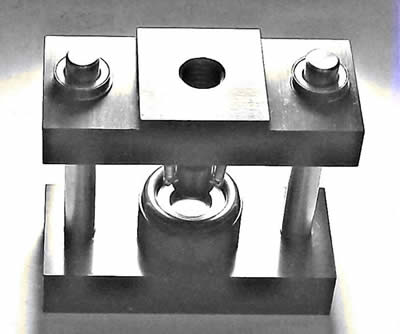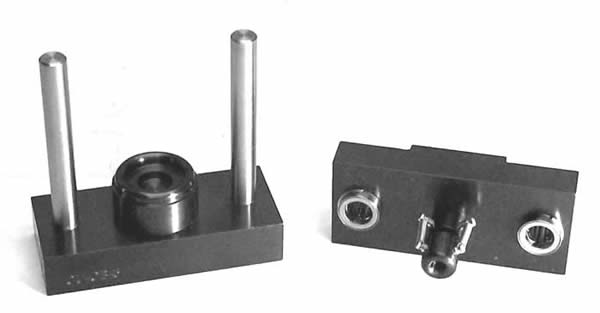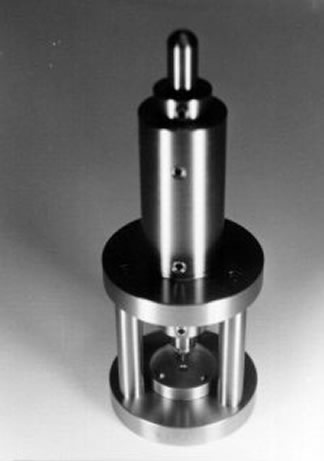Ceramic Equibiaxial Flexural Strength Test Fixture (ASTM C1499 & ASTM F394)
Model No. WTF-CB (Stainless Steel)

Fig. 1: Assembled test fixture without specimen.
ASTM C1499 (Reference 1) is a relatively new standard, introduced in 2001. A thin circular disk (a square specimen is also permitted) of a monolithic ceramic material, or a whisker- or particle-reinforced ceramic matrix composite, is supported on a ring and loaded by a smaller diameter concentric ring, a so-called ring-on-ring loading. The required diameters of the support and loading ring are dependent on the thickness and material properties of the specimen being tested. The standard gives expressions for calculating these parameters.
In order to attain a uniform load distribution, either the specimen surfaces must be very flat (typically by surface grinding), or a relatively thick (one-half the specimen thickness) sheet of a compliant material (e.g., rubber) is placed between each ring and the specimen. As another aid to achieve uniform loading, the loading head is articulated, being supported on a spherical seat. In spite of these uniform load introduction concerns, this test method is gaining in popularity. This fixture, assembled and disassembled, is shown in Figs. 1 and 2.

Fig. 2: Disassembled test fixture.
In addition to ASTM C1499, written for advanced ceramics in general, ISO 13356 (Reference 2) is available for ceramic surgical implant materials, and yttria-stabilized tetragonal zirconia (Y-TZP) in particular. It utilizes the same type of fixture, but specifies a specific size, namely, a 30mm support ring, a 12mm loading ring, and a 2mm cross-sectional radius of the rings.
Another, much older ASTM test method, ASTM F394 (Reference 3), first introduced in 1974, is still occasionally used, in spite of being discontinued by ASTM in 2001. The test fixture is shown in Fig. 3. A 1.25 in. diameter thin disk of the ceramic material to be tested is supported on three 0.125 in. diameter balls equally spaced around a 1 in. diameter circle. A compressive loading is applied at the center of the disk specimen by a 0.0625 in. diameter, flat-ended hardened steel rod. A thin (0.002 in. thick) polymer film (e.g., polyethylene) is placed under the 0.0625 in. diameter flat-ended loading rod, to more uniformly distribute the applied loading. The minimum thickness of the specimen must be such that its center deflection at failure does not exceed one-half the specimen thickness.

Fig. 3: Assembled ASTM F394 fixture without specimen
One important advantage of this biaxial test configuration is that specimen warpage is not an influencing factor, as opposed to the ring-on-ring test (ASTM C1499). Specimen warpage is also a problem when flexural testing a straight beam (Reference 4), requiring an articulating test fixture.
Both biaxial test methods have an advantage relative to a flexural test of a straight beam in that the maximum (biaxial) tensile stress occurs at the center of the specimen on the lower (convex when deflected) side. Thus, the surface finish of the edge of the specimen is not critical. This is not the case when flexural testing a straight beam.
Sources of Additional Information:
1) ASTM Standard C 1499-09 (2013), “Monotonic Equibiaxial Flexural Strength of Advanced Ceramics at Ambient Temperature,” American Society for Testing and Materials, West Conshohocken, PA (first issued in 2001).
2) ISO 13356, "Implants for Surgery - Ceramic Materials based on Yttria-Stabilized Tetragonal Zirconia (Y-TZP)", International Organization for Standardization, Geneve, Switzerland, 1997.
3) ASTM Standard F 394-78 (Reapproved in 1996 and then Discontinued in 2001), "Biaxial Flexure Strength (Modulus of Rupture) of Ceramic Substrates," American Society for Testing and Materials, West Conshohocken, PA (first issued in 1974).
4) ASTM Standard C 1161-13 (2013), "Flexural Strength of Advanced Ceramics at Ambient Temperature," American Society for Testing and Materials, West Conshohocken, Pennsylvania (first issued in 1990).

